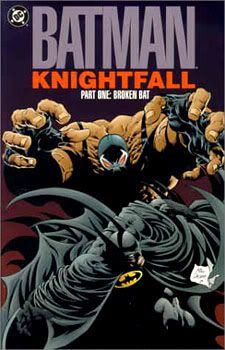Comic Book Review: Batman: "Knightfall" Part One: Broken Bat

Batman "Knightfall" Part One: Broken Bat (1993)
Collecting Batman issues 491-497 and Detective Comics issues 659-663. Writers: Doug Moench and Chuck Dixon, Pencillers: Jim Aparo, Norm Breyfogle, Graham Nolan, and Jim Balent, Inkers: Scott Hanna, Norm Breyfogle, Jim Aparo, Tom Mandrake, Bob Wiacek, Josef Rubinstein, and Dick Giordano, Colorist: Adrienne Roy. Originally published by DC Comics in 1993.
Tired of screwing around with movie-related Batman stories like Year Two or Tales of the Demon, I decided to borrow the highly recommended Knightfall series. It turns out that one of few random Batman comics that I own is the first issue of the series, so, 12 years later I get to find out how it turns out. About time, I say.
It turns out, that part one of the three part collected set is pretty damn good. The story begins with a breakout of Arkham Asylum of all its most dangerous prisoners, engineered by the villain known as Bane. This means that, in one instant, Batman has to deal with the escaped Killer Croc, Poison Ivy, The Mad Matter, Film Freak, The Scarecrow, The Ventriloquist, Zsasz, Cornelius Stirk, Amygdala, Two-Face, The Cavalier, Firefly, The Riddler, and The Joker, all while the threat of Bane and his trio of accomplices looms. The escapees all set about striking against Gotham City and Batman immediately upon release, which was Bane's plan all along. He freed the inmates as way to test Batman and his abilities, and to wear him down so that Bane could eventually destroy him.
To make matters worse, Batman is already pretty sick and weakened before the breakout even began. At the precise time where he would be better off resting and allowing his young accomplices Robin and Azrael (Jean-Paul Valley) take care of Gotham, he has no time for rest and more need to operate alone. As Batman dispatches the villains, he is so weary that he fails to understand that the entire strategy of breaking the villains out was a plan to make him weary. He attempts to see the crimes as inter-connected, as though the villains are working with Bane, even as Robin points out to him that they are a random distraction from the real opponent.
The pacing of the story is brilliant, as Bruce Wayne moves from one crisis to the next with little room for rest or recovery. The action is fast-paced and thrilling, giving the reader a variety of battles and villains stacked on top of one another. In one issue, Batman and Robin are busting up a Mad Hatter tea party, in another, Batman is ending a Zsasz killing-spree in an all girl's school, then Bruce Wayne is at a charity function where Poison Ivy attacks and kidnaps the attendees. The stories are on one hand self-contained issues with individual threats, and on the other a unified story building towards the ultimate showdown with Bane. In some ways, the book is like a video game, where you battle minor thugs and solve clues throughout the stage, meet up with a minor boss, while progressing to the biggest threat. And Bane is set up as a huge threat, not only through his masterminded Arkham attack, but also in physical altercations he has with different (non-Batman) characters leading up to the climax.
He'd have to be a strong villain, considering that on the way to fight him Batman has to first dispose of The Scarecrow and The Joker. When that team is on the undercard, you know the main event has to be huge. Although, the battle itself, while full of pathos, isn't a classic dust up. Which isn't a let down, but rather is a result of Bane's plan. He gets what he wanted, a nearly defeated Batman. Batman gamely attempts to make one more go of it, but he is beyond exhausted and over-matched. When the book concludes, it does so with one of the more shocking and memorable images in Batman's history. Or, at least it would be shocking if it weren't promoted so heavily and this wasn't 11 years after the story was published.
The series is a pretty good starter story for a Batman beginner or novice like myself. With so many different villains throughout the series, the reader gets a great glimpse into the various characters that make up the Dark Knight's rogue gallery. Since they all have different psychosis and intents, we get a good indication of the many different things Batman can do to beat an opponent. The Jean-Paul Valley character was the most unfamiliar to me, as I'd read and seen nothing previously with him in it, but the series explains him enough throughout to get a handle on him (which is important, as he has a bigger role to play in the next part of the series).
As far as technical details go, the art is all pretty good, if not spectacular. It does its job in telling the story, and handles variety of characters and situations well. The dialogue works, but isn't snappy and quotable (which is fine, I'm not sure if snappy dialogue would have fit the mood of the story). I wasn't a big fan of the mini-subplot involving a psychologist from Arkham going on the local talk shows to promote his book, because the whole thing felt like a cheap imitation of Frank Miller's Dark Knight Returns. But, at least it had a bit of a payoff with The Riddler later on. Overall, I found part one of the series an excellent modern Batman story.
4.5/5
Related:
Batman - "The Dark Knight Returns"
Batman - "Knightfall" Part Two - Who Rules the Night
Batman - "Knightfall" Part Three - Knightsend